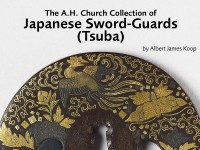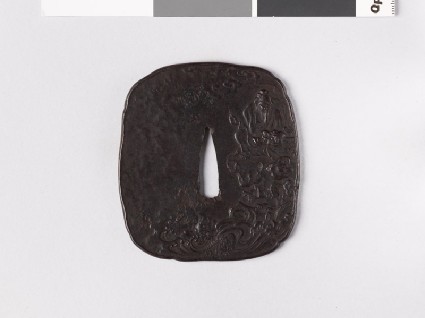The A. H. Church Collection of Japanese Sword-Guards (Tsuba)
An unpublished catalogue of the A. H. Church collection of Japanese sword-guards (tsuba) by Albert James Koop.

Publications online: 1264 objects
Tsuba depicting Bashikō about to perform acupuncture on a dragon
-
Literature notes
Of very irregular outline, but generally rounded oblong, with hammered-up edge; decorated in soft low relief with the Taoist magician Ma Shi-huang seated on a rocky ledge; from the waves below issues a dragon, whose throat he is about to cure by acupuncture; at the back is a man crouching asleep beneath a pine-tree, with a rain-storm swirling overhead. Unsigned, but inscribed: Tōyei-zan no hotori ni oite ("in the neighbourhood of Tōyei-zan," Kiōto) mei no gotoku ("by order") kore wo horu ("carved this").
F. V. Dickins Collection. Possibly one of a pair of tsuba, the other bearing the artist's name. Interesting as being a complicated and elaborate design, without any inlay or incrustation.
Ma Shih-huang (Japanese, Bashikō), one of the sennin (hsien-jên), was a legendary physician of China (2697-2597 BC) who is said to have cured a sick dragon by acupuncture and a draight of licorice, and to have been carried up to heaven by the grateful creature. -
Details
- Associated place
- Date
- 19th century (1801 - 1900)
- Material and technique
- iron, with hammered-up edge
- Dimensions
- 8.1 x 7.4 cm (height x width)
- Material index
- Technique index
- Object type index
-
arms/armour › koshirae › kodogu › tsuba
- No. of items
- 1
- Credit line
- Bequeathed by Sir Arthur H. Church, 1915.
- Accession no.
- EAX.11251
-
Further reading
Koop, Albert James, The A. H. Church Collection of Japanese Sword-Guards (Tsuba), 3 vols (Oxford, Ashmolean Museum, 1929), no. 1251
Glossary
tsuba
-
tsuba
Japanese sword guard.
Location
-
- currently in research collection
Objects are sometimes moved to a different location. Our object location data is usually updated on a monthly basis. Contact the Jameel Study Centre if you are planning to visit the museum to see a particular object on display, or would like to arrange an appointment to see an object in our reserve collections.
Publications online
-

The A. H. Church Collection of Japanese Sword-Guards (Tsuba)
Of very irregular outline, but generally rounded oblong, with hammered-up edge; decorated in soft low relief with the Taoist magician Ma Shi-huang seated on a rocky ledge; from the waves below issues a dragon, whose throat he is about to cure by acupuncture; at the back is a man crouching asleep beneath a pine-tree, with a rain-storm swirling overhead. Unsigned, but inscribed: Tōyei-zan no hotori ni oite ("in the neighbourhood of Tōyei-zan," Kiōto) mei no gotoku ("by order") kore wo horu ("carved this").
F. V. Dickins Collection. Possibly one of a pair of tsuba, the other bearing the artist's name. Interesting as being a complicated and elaborate design, without any inlay or incrustation.
Ma Shih-huang (Japanese, Bashikō), one of the sennin (hsien-jên), was a legendary physician of China (2697-2597 BC) who is said to have cured a sick dragon by acupuncture and a draight of licorice, and to have been carried up to heaven by the grateful creature.
Notice
Object information may not accurately reflect the actual contents of the original publication, since our online objects contain current information held in our collections database. Click on 'buy this publication' to purchase printed versions of our online publications, where available, or contact the Jameel Study Centre to arrange access to books on our collections that are now out of print.
© 2013 University of Oxford - Ashmolean Museum

